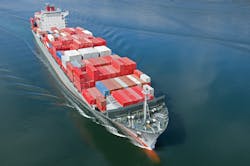Looking into the shipping landscape for 2024, ContainerXchange recently released a report looking at potenteial scenarios for the industry.
Here are exccepts from the report.
Reduced demand and oversupply intensify competition, leading to lower profits in 2024
Competition in the shipping industry has long been a key factor affecting profitability; the break of alliances can have significant impacts on the market dynamics. In 2023, Maersk and MSC announced that their longstanding 2M alliance, set to expire in 2025, would not be renewed, marking a significant shift in the maritime industry. The repercussions of this decision are expected to have a lasting impact throughout 2023 and 2024. This stems from the primary drivers of less demand and oversupply, ultimately leading to heightened competitive pressures and, consequently, lower profits.
MSC, in particular, has been making strategic moves, acquiring 271 secondhand vessels with a combined capacity of over 1 million TEUs since August 2020. This remarkable growth has propelled MSC to the top position in the industry, surpassing Maersk.
This shift in the industry dynamics opens the door to several potential scenarios. One possible outcome is that the maritime sector, especially as it enters a phase of potential overcapacity, could witness a fierce competition for market share among carriers. This competition might drive down profits, potentially necessitating further rounds of mergers and acquisitions (M&A), particularly if regulatory bodies take action against carrier alliances.
Once MSC completes its vessel acquisitions currently on order, it is expected to be 30 to 35% larger than Maersk in terms of capacity. The repercussions of this strategic shift are likely to reverberate throughout 2023 and 2024, shaping the future of the maritime industry.
Container line schedule reliability on the rise, yet challenges persist
Container line schedule reliability is continuing to improve returning to prepandemic levels. The current situation is better than a year ago when 79% of ships arrived with an average of 7.9 days delay. But compared to normal market conditions, there is still room for improvement.
Global schedule reliability declined by -0.9 M/M in August 2023 to 63.2%. Barring the increase in May, schedule reliability has been ranging within 2 percentage points since March 2023. On a Y/Y level, schedule reliability was 17.0 percentage points higher.
With 70.9% schedule reliability in August 2023, MSC was the most reliable top-14 carrier, followed closely by Maersk and Hamburg Süd with 70.0%. CMA CGM was the only carrier with schedule reliability of 60%-70%. 8 of the remaining carriers had schedule reliability of 50%-60%, with HMM and Yang Ming under 50%; the latter the least reliable at 47.3%.
Only 3 of the top-14 carriers recorded a M/M increase in August 2023, with OOCL recording the largest increase of 2.8 percentage points. On a Y/Y level, all 14 carriers recorded double-digit improvements, with MSC recording the largest improvement of 26.8 percentage points.
When asked about the container line schedule reliability in 2024 survey respondents said:
Improve – 47%
Same – 36%
Deteriorate-17%
Blank sailings to increase in 2024 as market volatility persists
In 2021-2022, carriers added extra voyages to meet rising demand, but supply chain issues caused ships to get stuck in port queues, resulting in numerous cancellations despite increased capacity. The continuous expansion of shipping capacity, driven by the introduction of new mega-vessels, is outstripping the existing demand, leading to considerable strain on already oversupplied trade lanes.
Completely disengaging from China is a challenging task, given the extensive electronic supply chains that China has meticulously developed over the past two to three decades. However, an increasing number of companies are making strategic moves to relocate their final manufacturing and assembly processes outside of China, while still relying on Chinese suppliers for essential raw materials.
Although they were more organized in 2023 than last year’s sporadic cancellations, blank sailings are still used to stabilize market rates and exert upward pressure on specific trade routes, fueled by surging market demand and carrier actions.
In 2023, there have been significant fluctuations in blank sailings across major shipping routes, reflecting the dynamic global shipping industry influenced by factors such as market conditions, disruptions, and demand patterns. Blank sailings peaked at 21% early in the year but dropped to 10% in weeks 8 to 12, indicating industry stabilization. Throughout the year, blank sailings remained low, reaching 4% in weeks 25 to 29, signifying a more consistent schedule.
When asked: With increasing global shipping capacity, how will blank sailing percentage change in 2024 compared to 2023?
Increase – 63%
Same as 2023 -- 28%
Decrease -9%
Container availability to remain highly imbalanced in 2024
As the Euro Zone grapples with an ongoing economic crisis, facing declining trade and subsequently, a drop in container trade, the region struggles with the challenge of surplus containers causing repositioning costs exceeding the asset cost. Industry predicts that the container lessors are more focused on long term strategies so that the cost of repositioning may result extremely diluted over the asset lifetime.
The excess of inbound containers this October is also evident in the Container availability Index (CAx) which measures the inbound and outbound containers at any given port. For Rotterdam, the values are at an all-time high at 0.70 this October as compared to 0.59 in October 2022. This indicates that the burden of containers is significantly higher in Rotterdam.
